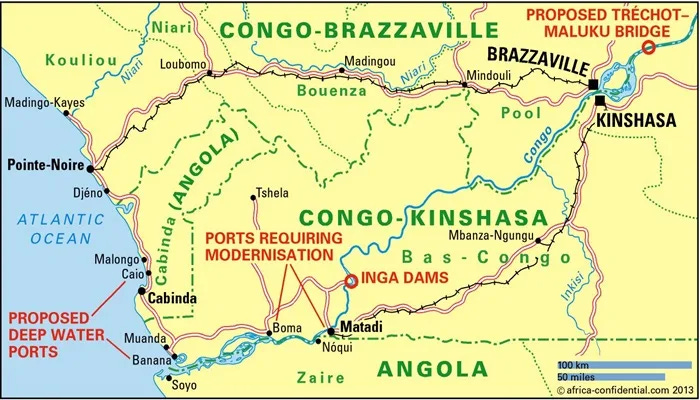Five projects to unlock the Congo Corridor
and advance commercial diplomacy in Central Africa
In our last post, we introduced the concept of the Congo Corridor: a strategic development zone stretching from the Atlantic port of Matadi through Kinshasa to the inland hub of Kisangani. This route has the potential to unlock the DRC’s vast natural resources, strengthen regional ties, and serve as a model for development built on logistics, energy, and trade.
For the United States, it’s a chance to show what commercial diplomacy can achieve when aligned with local potential and global need.
Turning this vision into reality means focusing on a few high-impact projects that can serve as the foundation. Here are five that could form the backbone of the Congo Corridor.
1. Harness hydropower at Grand Inga
Thanks to the Congo River, the DRC holds more untapped hydropower potential than any other country on Earth.1 The long-planned Grand Inga Dam alone could generate nearly twice the output of China’s Three Gorges Dam, making it the largest hydroelectric facility in the world.2 If realized, the Inga complex could electrify Congo and help export clean power to other areas in Africa, fueling industry, reducing energy poverty, and leapfrogging fossil-dependent development.
Despite decades of discussion, Grand Inga has stalled due to financing, coordination, and competing stakeholder agendas. Embedding it within a larger Congo Corridor vision could help align interests and re-energize support from institutions like the World Bank. The Corridor provides the strategic context Inga has long lacked.
2. Upgrade inland shipping from Kinshasa to Kisangani
The Congo River is a natural inland highway, but it remains underused. Today, only 203,000 tons of freight move annually between Kinshasa and Kisangani, which is a fraction of what’s possible.3 Targeted investment in port upgrades, dredging, river signaling, and modern vessels could substantially increase that volume.
Unlocking the river would lower transportation costs, reduce dependence on roads, and connect the interior more directly to global markets. Like the Mississippi in the United States or the Nile in Egypt, the Congo River can serve as the commercial spine of a continent. Making it navigable is essential to the corridor’s success.
3. Improve transportation from Banana to Matadi to Kinshasa
The Banana–Matadi–Kinshasa corridor is emerging as a vital logistics artery in the DRC, with two major infrastructure projects improving connectivity to global trade routes in an area where the Congo River is not navigable.
First, the DRC government has announced a $956 million plan to modernize the 366-kilometer railway between Matadi and Kinshasa. This initiative aims to revitalize a key transport link that has suffered from decades of underinvestment. The upgrade is expected to significantly reduce transport times and costs between Kinshasa and the country's primary seaport.4
Second, a new 450-kilometer highway is planned to connect Kinshasa to the deepwater port of Banana via Matadi. The DRC government has signed a memorandum of understanding with China's Zhongshi Wozen Technology Co. LTD for its construction. Once complete, the highway is expected to enhance access to the Atlantic coast and boost the competitiveness of both ports.5
There is still significant opportunity to invest in multimodal system linking rail, road, and river to the seaport. Strengthening this infrastructure is a key step toward fully connecting the Congo Corridor to global trade.
4. Build special economic zones along the corridor
For the DRC to move beyond raw resource extraction, it needs to create value at home. Special Economic Zones (SEZs) can help make that shift by concentrating infrastructure, talent, and investment in key hubs along the Congo Corridor.
These zones would support mineral processing, light manufacturing, and export-oriented industries. With streamlined regulations, tax incentives, and access to reliable power and transport, SEZs could attract both domestic and international capital.
By capturing more value from Congo’s resources before they leave the country, SEZs could boost government revenue, create skilled jobs, and lay the foundation for more diverse and resilient economic growth. They also help reduce risk for investors by offering a more stable and business-friendly environment.
5. Map the region using geospatial intelligence and other technology
The Congo River is one of the least mapped major rivers in the world. Without reliable data on its shape, depth, and seasonal changes, it’s difficult to plan long-term infrastructure, much less use it reliably for transportation.
Investing in modern mapping tools like satellites, drones, and on-the-ground surveys would provide a much clearer picture of the river and the surrounding landscape. This would support smarter infrastructure planning, improve navigational safety, and help identify stronger connections between the Corridor, the Copperbelt to the south, and neighboring countries to the east.
Better mapping would also help the DRC manage its natural resources. From minerals to forests to water systems, knowing what’s there is essential for both development and conservation. Mapping the Corridor is a key step toward more informed planning, deeper regional integration, and greater national control over the country’s future.
Why this matters to the U.S.
The Congo Corridor would unlock one of the world’s most promising regions. These five projects represent the foundation, but the impact could extend well beyond Central Africa.
For the U.S., supporting the Congo Corridor is a rare opportunity to align strategic and economic priorities. It offers a way to counter China’s growing influence, secure access to critical minerals and other key resources, and help stabilize a region long held back by underinvestment and outside exploitation. It also supports U.S. trade by accelerating energy development and opening new markets for American businesses.
The Corridor would build on the momentum of the Lobito Corridor and demonstrate the power of commercial diplomacy as a tool of U.S. foreign policy.
Let us know your thoughts, and stay tuned as we continue to shape this vision.







![[object Object] [object Object]](https://substackcdn.com/image/fetch/$s_!0eVV!,w_1456,c_limit,f_auto,q_auto:good,fl_progressive:steep/https%3A%2F%2Fsubstack-post-media.s3.amazonaws.com%2Fpublic%2Fimages%2F15204760-61e5-49e0-bf68-29f24804ce36_876x731.png)


Number one is a difficult task with the degreee of corruption the DRC sistemically surfers
https://africa-energy-portal.org/news/drc-why-did-acs-exit-completely-inga-iii-hydroelectric-project